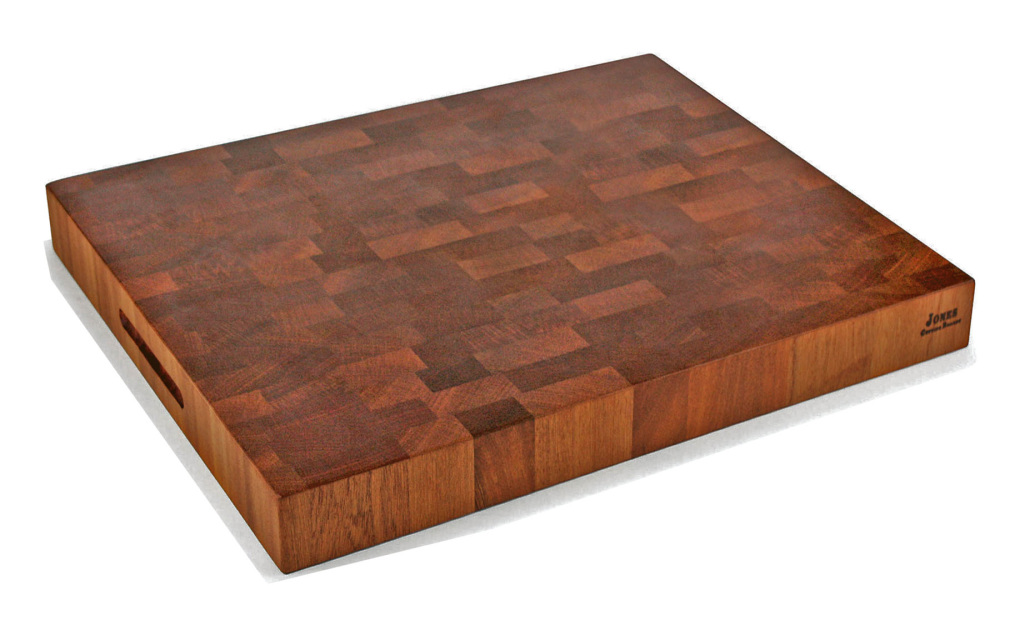- Large End Grains
- >
- 22x16x2 Mahogany End Grain
22x16x2 Mahogany End Grain
SKU:
$342.00
342
388
$342.00 - $388.00
Unavailable
per item
Due to a recent surge in orders from popularity we will have a 2month construction time on new orders. Thanks for your patience!
Handcrafted from the highest grade solid Sapele hardwood also referred to as African Mahogany
End grain layout doesn't dull expensive knife blades & self heals from cutting use
Premium Wood Glue
22"x16"x2"
Finger Grips applied to side ends for easy lifting
Multiple coats of FDA grade mineral oil applied, then buffed with a moisture resistant bees wax top coat finish
FREE SHIPPNG to anywhere in the U.S. (Excluding Alaska & Hawaii)

Cutting Boards Made To Last- Being a smaller family business we pay close attention to the little details that make our work unique and our boards at a high quality control. Intricate staggered block layout to achieve the strongest wood joints possible. Clamping and wood preparation technique from a company that specializes solely in cutting boards allows for some of the tightest glue ups available on the market.
5stage sanding process makes for a smooth as butter feel
Whether you're a professional chef or a avid home cook this is a must have tool for the kitchen. Keep your knife blades sharp with this end grain constructed board. The wood configuration allows the blade to cut between the wood fibers not across and when the knife is lifted the fibers return to the original form. This design allows for a board that will outlast generations of users.
History & Info of the Tree hardwoods used in this board-
Sapele is a large tree naturally that has a widespread growth range across Africa. It is common for the trunk to exceed 6 feet in diameter and it has a very straight trunk with little to no branching below 80 feet. This yields very straight grained, wide and long lumber in great abundance per log. The hardwood has excellent moisture resistance and is even used for outdoor applications. While the grain pattern is still moving in the same direction, the interlocking pattern acts to cancel out a lot of movement that is typically found across the grain. This hardness and medium density as well as propensity for straight grained boles (central trunk of the tree) makes. As well as housing protein-rich caterpillars, the sapele is also critical to local communities for their medicinal and structural properties. The bark of the sapele is believed to have anti-inflammatory properties and is used for the treatment of headaches, eye infections and swollen feet, and the trunk is used for dug-out canoes and the central roof support in homes. Sapele trees provide habitat for a number of rare monkeys in the Congo(Thus why we call it the Congo Board.)
5stage sanding process makes for a smooth as butter feel
Whether you're a professional chef or a avid home cook this is a must have tool for the kitchen. Keep your knife blades sharp with this end grain constructed board. The wood configuration allows the blade to cut between the wood fibers not across and when the knife is lifted the fibers return to the original form. This design allows for a board that will outlast generations of users.
History & Info of the Tree hardwoods used in this board-
Sapele is a large tree naturally that has a widespread growth range across Africa. It is common for the trunk to exceed 6 feet in diameter and it has a very straight trunk with little to no branching below 80 feet. This yields very straight grained, wide and long lumber in great abundance per log. The hardwood has excellent moisture resistance and is even used for outdoor applications. While the grain pattern is still moving in the same direction, the interlocking pattern acts to cancel out a lot of movement that is typically found across the grain. This hardness and medium density as well as propensity for straight grained boles (central trunk of the tree) makes. As well as housing protein-rich caterpillars, the sapele is also critical to local communities for their medicinal and structural properties. The bark of the sapele is believed to have anti-inflammatory properties and is used for the treatment of headaches, eye infections and swollen feet, and the trunk is used for dug-out canoes and the central roof support in homes. Sapele trees provide habitat for a number of rare monkeys in the Congo(Thus why we call it the Congo Board.)

